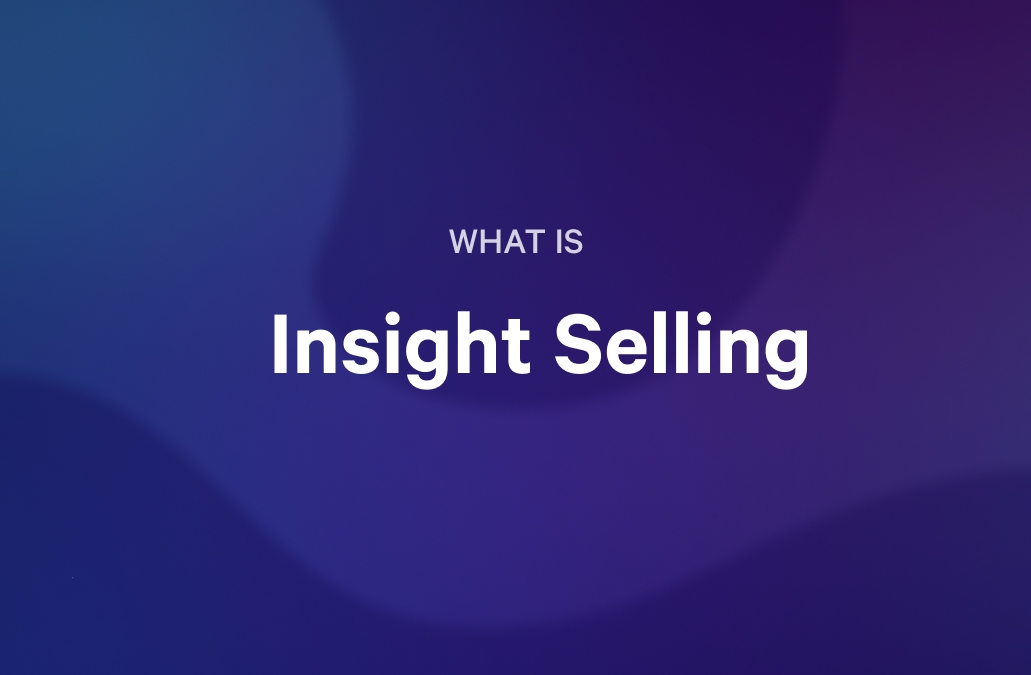Sales methodologies are structured approaches to selling that can help your sales reps reach your destination. Everyone might know where you’re going, but without a structured approach, you might have five different reps taking five different paths to get there.
Picking a sales methodology helps your team stay on track and gives them the tools they need to reach their desired outcome—more closed deals—in a more reliable way. Having some structure to sales calls and other sales activities can help boost sales performance and give sales leaders valuable data about what is working.
That’s why using a proven sales methodology is a simple way to train and level up your sales team. But choosing the right method makes all the difference.
What is a sales methodology?
For sales reps to close deals more smoothly and with impact, sales teams need to implement an approach to selling- one that really hits home.
How can we make sure that every encounter with a sales rep delivers real worth to the customer? Well, by using a structured, data-driven, strategic approach.
A sales methodology is a framework a sales organization uses to guide the sales process. Most sales methodologies (or sales models) include a set of principles, strategies, and tactics designed to help sales reps effectively engage with prospects, ask the right questions, and identify buyer’s needs. The end goal? To close those deals!
So, think of it as a series of steps your sales team uses that allows reps to convert potential customers to solid buyers.
Why implement a sales methodology
80% of sales require five follow-up calls after the initial contact but, 44% of sales reps give up after one “no.”
Stats like these might encourage the negative perception that salespeople are far too persistent, but the numbers don’t lie. As all sales managers know, persistence is an absolute necessity.
A sales methodology standardizes your selling process, driving the adoption of best practices throughout your sales team.
Sales methodologies are widespread—and with good reason. They make a massive difference to the effectiveness of your B2B sales strategy by:
- Providing a guideline for your sales reps to follow when preparing for conversations with prospects.
- Empowering your salespeople to present your solution in a way that’s tailored to each individual prospect or the personas of their ideal customers.
- Eliminating the guesswork that often comes with selling.
- Making it easy for your sales organization to be consistent and treat all prospects similarly, reducing the likelihood of missed deals or opportunities.
- Saving time and helping your team become more efficient by qualifying prospects faster, reducing the sales cycle.
- Helping you codify and learn from your team’s experience to shape what effective selling looks like at your sales organization.
How to choose the right sales methodology for you
There are so many different sales methodologies, it’s easy to feel overwhelmed by choices.
But analysis paralysis doesn’t move your sales organization forward.
Some methodologies are easy to disqualify based on your industry or the type of product you’re working with, but you’ll probably still end up with many options that could work for your team.
Kegan Croxford, Sales Director at Mentally Fit South Africa, explains:
“The "right sales methodology depends on your team, customers, and business goals. No methodology is a silver bullet, but you will set yourself up for success by choosing one that aligns with your team’s strengths and is flexible enough to grow with you.”
When choosing the most suitable sales methodology for your team, you should consider your:
- Company goals and objectives
- Customer preferences and buying behavior
- Sales team strengths and weaknesses
- Market conditions and competition
- Product or service complexity
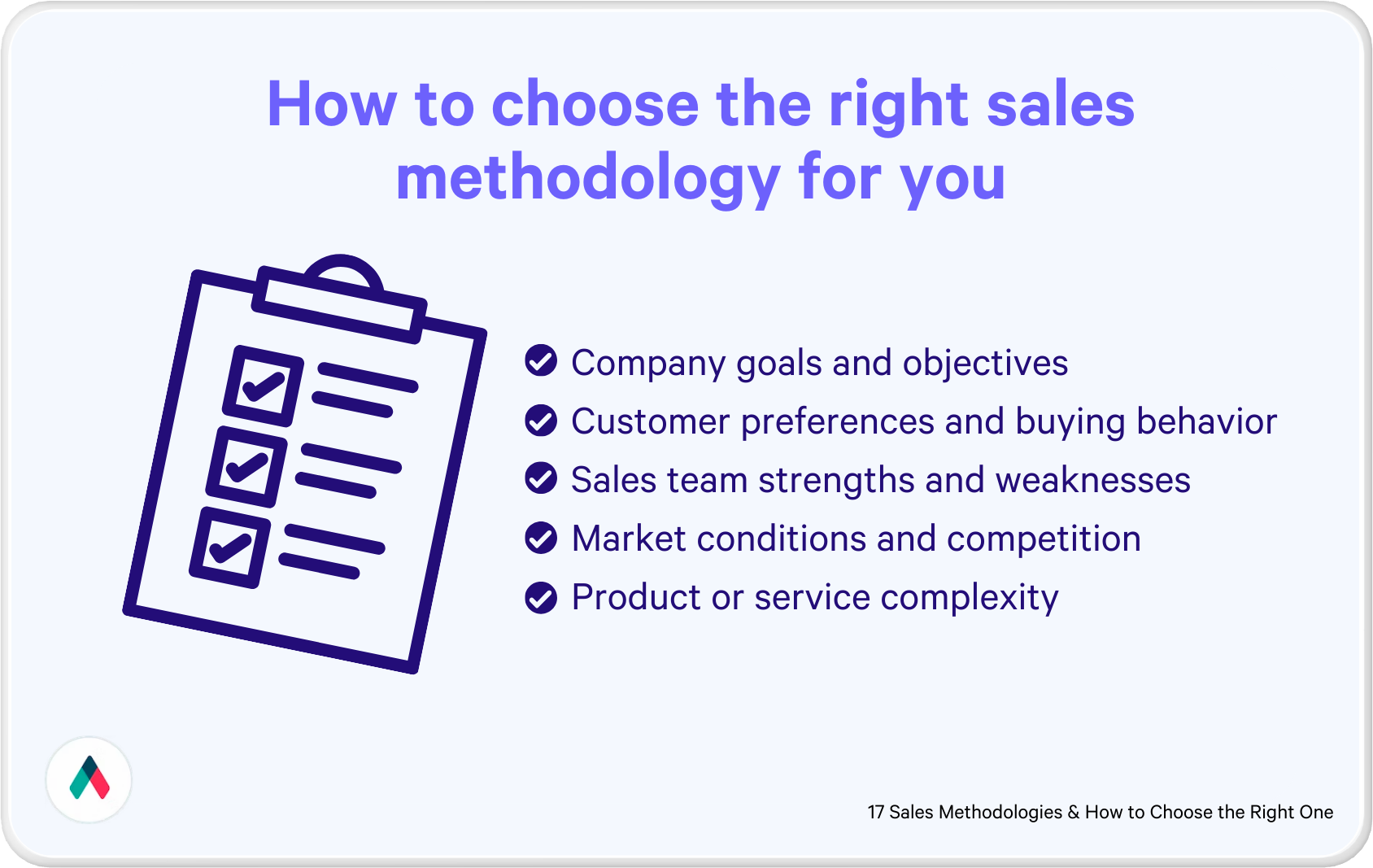
1. What are your company goals and objectives?
Your sales team is the key driver of your company’s future growth.
The sales methodology you choose has to be aligned with your company goals. If you need to increase market share in the short-term, you may need to choose a sales methodology that emphasizes aggressive sales prospecting and lead generation, like Challenger selling.
When resources are extra tight, it might also be worth working with a methodology like MEDDIC that allows you to disqualify prospects early on—enabling you to focus your attention on deals that have a higher likelihood of success.
But if your objective is to increase customer loyalty, you might choose something that helps build long-term relationships with customers, like Gap selling or Sandler sales.
2. What are your customer preferences and buying behavior?
Most customers prefer personalization. The research shows, 64% of buyers look for personalized materials, and 25% dismiss generic collateral.
This would suggest that using a sales methodology to build rapport and offer tailored solutions, such as SPIN selling, might be ideal. That said, some customers value convenience and efficiency more, highlighting how the right choice really depends on your customer base.
“Align your choice with the customer journey. If your clients are looking for quick solutions a methodology that emphasizes a simple decision-making process would be a good option. However, for longer cycles that focus on qualifying leads and understanding the decision-making, a methodology like MEDDIC may fit better. Match your methodology with how your customers buy. The methodology of choice should be able to scale with your business as you grow - Flexibility is key”.
Kegan Croxford, Sales Director
3. What are your sales team strengths and weaknesses?
Fact is, some sales methodologies just may not mesh with your sales team.
Sales representatives (called lone wolves by the folks that developed Challenger) often develop an individual style and approach to selling, using tips and tricks that each individual is confident they can effectively implement.
That doesn’t mean it’s not worth trying them out and seeing which approach drives the best results. There’s always room for training and development, and with the right sales enablement, you can help anyone get better at applying a specific methodology.
But sometimes, the juice just isn’t worth the squeeze.
Giving your team tools to approach their sales conversations in a better way is a win for all.
4. What are the market conditions and competition?
The market often dictates what’s successful and what isn’t.
If your competitors are successfully using a particular sales methodology, you may want to consider adopting a similar or contrasting approach. A contrasting approach can differentiate your brand, attracting prospects with different needs than your competition's.
5. What is the complexity of your product or service?
Highly complex products and services require a different touch.
There’s a huge difference between selling products where the value proposition is straightforward, simple, and obvious and a product geared towards enterprise customers with a team of decision-makers.
More complex products benefit from an involved selling strategy, such as Gap selling, or a proof of concept sales approach.
What's working today
Before we dive into the full list of methodologies, we recently hosted Richard Harris, Founder @ The Harris Consulting Group and Nathan Clark, Director Global Sales Enablement @ UpGuard, to discuss popular sales methodologies and their relevance in the world of modern selling, with recommendations to maximize sales success.
We think it's a great conversation that adds color to what can be quite a nuanced topic:
Why it’s important to use the right sales methodology
- Improved sales performance: an effective sales methodology equips your sales team with clear techniques and processes to perform at their best within a specific environment.
- Boosted efficiency: A streamlined path to guide customers saves time and energy, allowing reps to focus on meaningful conversations that add value to each encounter. When every interaction is purposeful, less time is lost in trial and error.
- Faster onboarding: A mapped-out sales approach reduces the learning curve, allowing newcomers to integrate smoothly into the team, understand best practices, and start contributing faster. This will set them up for early wins, and will do wonders for their confidence.
- Company culture: A consistent approach reinforces the company culture, fostering a shared language and approach that helps even the newest members operate like seasoned pros. The benefits are twofold: ramped-up times and stronger long-term performances.
- Satisfied customers: When customers know they can expect high-quality service at every touchpoint, it reinforces their belief in the brand. Herein lies a secret power: Customers end up referring others and spreading positive word of mouth, which is invaluable in today’s competitive market.
- Scalability for growth: As the business grows and the team expands, new hires can plug into an established framework, helping the team handle increased demand without sacrificing quality. Scalability is essential for companies aiming to enter new markets or scale operations, and a reliable methodology is the backbone of that growth.
- Enhanced sales team collaboration: Sales teams operate best when they’re rowing in the same direction, and a shared sales methodology creates that sense of unity. When everyone works together to achieve common goals, this alliance fuels collective momentum, making the team stronger and more adaptable as they learn from each other's experiences.
- Sharper vision into sales performance: Insights gathered from a standardized process are like a compass, pointing the team toward the most promising strategies and helping them avoid pitfalls: decisions are based on patterns and evidence rather than guesswork.
Check out our guide on sales collaboration tools
17 popular sales methodologies to consider
Sales methodologies vary widely in what they offer and how sellers use them. Some define specific steps for the entire B2B sales process. Others are more suitable during one or more parts of the sales process like qualifying leads or closing deals. These types of methodologies don’t usually include steps to follow but rather suggest a general sales approach (like consultative selling) or questions to ask (such as Neil Rackham’s SPIN selling).
You can mix and match different methodologies and sales models based on your prospects, customers, industry, and sales strategy.
We'll cover:
Popular Sales Methodologies
- Gap Selling
- Challenger Selling
- MEDDIC
- MEDDPICC
- Sandler Sales
- Spin Selling
- Solution Selling
- Conceptual Selling
- Transactional Selling
- Consultative Selling
- Value Based Selling
- Proactive Sales
We'll also touch on:
1. Gap Selling
In the Gap Selling methodology, the sales rep is charged with understanding both the prospect’s current state and desired future state. Then it focuses on the sales messaging and their solution to addressing the gap between the two.
This methodology was developed by Keenan, a well-known sales coach and the CEO of ASG (A Sales Growth Co.) and the author of the book, Gap Selling: Getting the Customer to Yes. Keenan encourages sellers not to take buyers’ words for granted at the beginning of the sales process and to get to the heart of the issue causing the gap. This will allow the seller to pitch their solution to close the gap for their prospect effectively.
Suitable for: Complex sales environments with longer sales cycles and prospects with issues that clearly need to be solved. It may not be suitable for those who sell luxury products or services that are viewed as nice to have.
2. Challenger Selling
Challenger selling, as documented in best-selling The Challenger Sale by Brent Adamson and Matthew Dixon, is effective, but it can take more work to get right. It involves challenging the customer's assumptions and offering new insights to solve their pain points and business challenges.
It’s great during economic downturns or when working with established companies that move slowly because it encourages you to provoke your prospects and convince them that not spending is missing out on opportunities. The Challenger Sale methodology emphasizes the importance of building credibility and trust with customers by providing value and insight—often making them think about things in a new way or questioning the status quo —and when done well, it can help differentiate you from your competition.
Suitable for: Industries such as technology, healthcare, and finance, where customers have complex business challenges that require new solutions.
Expert tip:
“My top tip for implementing the Challenger Sale methodology is to focus on training your sales team to confidently lead with insight and provide value upfront. This involves a mindset shift from simply "selling" to becoming a strategic partner who understands the client’s challenges better than the client themselves. Invest in customer research to also equip your team with insights that are relevant.”
Kegan Croxford, Sales Director at Mentally Fit South Africa
3. MEDDIC
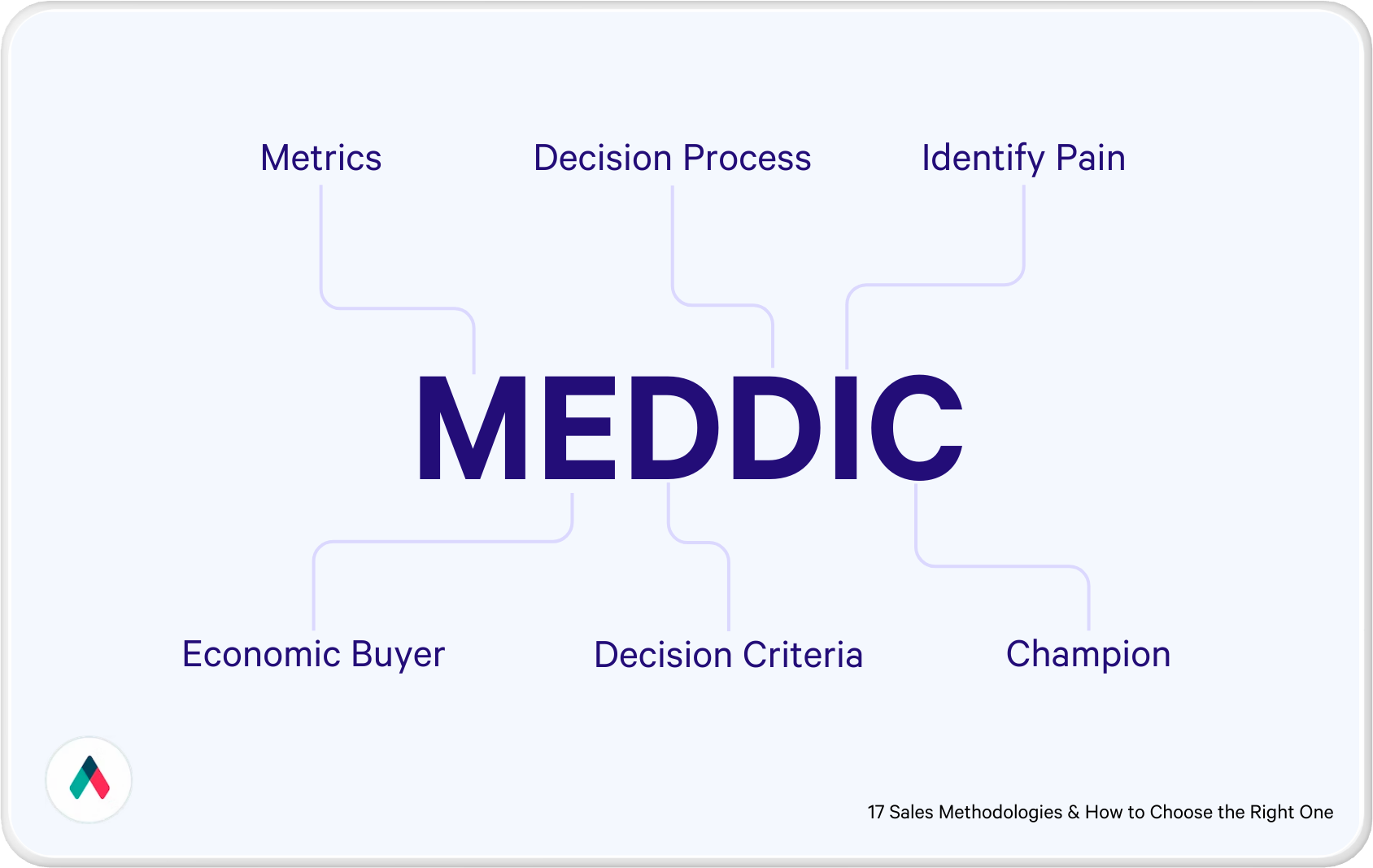
MEDDIC is an acronym that stands for metrics, economic buyer, decision criteria, decision process, and champion. In this methodology, sellers are looking to identify the metrics used to quantify success in the deal and the economic impact. Then they need to seek out the economic buyer - this is the person on the buying team who can say yes to the deal when others say no and say no to the deal when others say yes. The seller also needs to understand both the decision process (who will make the decision and when) and the decision criteria (how the deal will be evaluated). And finally, they need to seek out a champion within their prospect’s organization. The champion is someone who can help sell the deal internally.
MEDDIC is considered a qualification methodology, meaning most of this discovery work is done at the beginning of the sales process. It can be coupled with other methodologies to give sales reps a framework to engage the prospects through the rest of the sales process and guide them towards closing the deal.
Suitable for: Enterprise sales, technology sales, and sales teams who have a very specific ideal customer profile (ICP) who need to clearly evaluate if a prospect may move forward in the sales process.
Read next: Command of the Message
4. MEDDPICC
MEDDPICC is like MEDDIC 2.0. It adds a few letters to the acronym to help sellers achieve their goals. The P in MEDDPICC stands for paper process. As technology continued to advance, sales reps who sold longer-term SasS and tech deals began to realize that they needed a way to manage contract expirations and renewals, and thus the P for paper process was added to allow for this.
The other C in MEDDPICC stands for competition and encourages sellers to identify anyone or anything they might be competing with, including a no-decision and the prospect’s ability to keep the status quo.
Suitable for: SaaS and other technology sales teams with long contracts and the need for periodic renewals or upgrades.
5. Sandler Sales
The Sandler Sales System is a seven-step sales methodology that is consultative in nature. Because of this, it is considered a lower-pressure sales methodology. It starts by having the salesperson establish bonding and build a rapport with the prospect. The next step once a relationship has been established is to set up a contract or establish the roles and ground rules for doing business together. The third step in the Sandler process is to identify the prospect’s pain. This goes along with the next step which is to establish the budget. Then, the sales rep can focus on the decision-making process. From there, they will create an agreement that addresses the need, budget and is aligned with the decision process. The final step is to confirm the post-sales process and ensure they secure the deal.
Suitable for: Complex deals in the software, technology, managed services or consulting industries.
6. SPIN Selling
SPIN Selling is a sales model that can be used in a consultative and solution-based approach. It focuses on asking specific types of questions that are open-ended questions to identify the prospects:
- Situation
- Problems
- Implications
- Needs
The goal is to understand the prospect’s needs and decision criteria before making a sales pitch. It’s ideal for building credibility with prospects and discovering unmet needs.
Suitable for: Industries such as consulting, professional services, and software.
7. Conceptual Selling
In conceptual selling, you sell the concept or idea your project is based on rather than your product or service.
This means deeply understanding the prospect’s business goals and pain points before presenting a solution. An effective sale depends on positioning your product in a way that appeals to that individual customer's needs. Conducting research, asking questions, actively listening, and personalizing solutions are all essential components of conceptual selling.
Suitable for: Industries such as marketing, advertising, and media.
8. Transactional Selling
Transactional selling is often seen as a little old-school.
This is how people have envisioned sales to work forever: You’re aiming to make a transaction as quickly and efficiently as possible. The goal isn’t to build a long-term relationship or establish rapport with your prospects. It’s to make the sale.
Although it gets a bad rap sometimes, transactional selling does have some benefits. In other words, it works for some situations—usually when you’re aiming for high sales volume and sales efficiency. It’s not typically a good fit for high-value products or for SaaS businesses.
Suitable for: Industries such as retail, where customers make frequent, low-value purchases.
9. Solution Selling
Solution selling (Often refered to as customer-centric selling too), is a big jump upwards.
The focus here isn’t simply on selling your product (such as in transactional selling), but on identifying the customer’s pain points and presenting your product as a solution to that problem. It’s a great way to make sure you’re selling to the right prospects, encouraging long-term customer loyalty and higher retention.
Suitable for: Industries such as IT, healthcare, and finance, where customers have specific business challenges that require personalized solutions.
10. Consultative Selling
Consultative selling starts with collaboration. In some ways, it’s the next step up from solution selling.
What do buyers want from sales professionals in the first call? 69% of survey respondents say it’s “Listen to my needs.”
Consultative selling is an ideal sales method to achieve that.
The salesperson and the prospect work together to identify the customer’s needs before the salesperson provides a tailored solution that’s uniquely effective for them. As you’d expect, the goal here is to position your sales reps as consultants. Prospects should see them as people who are deeply knowledgeable about the industry and equipped to help solve their potential problems.
Consultative selling is a great way to build customer trust and rapport, identify upsell and cross-sell opportunities, and improve the buying process. But it requires highly skilled salespeople, who are experts in their industry.
Suitable for: Industries with complex or technical products or services, such as software or technology.
11. Value-Based Selling
Value-based selling focuses on understanding and enhancing the value that your product or service provides to the customer, rather than competing primarily on price. The central tenet of this methodology is to communicate the unique benefits and results that your offering can deliver, which are directly aligned with the customer’s core objectives and values.
The goal here is to showcase the potential ROI, improvement, or impact that your product can bring to the customer, thus justifying the investment they'll make. This requires a thorough understanding of the customer’s business, their pain points, and how your solution aligns with their strategic objectives.
Suitable for: Industries where the product or service can deliver a significant positive impact or ROI, such as technology, healthcare, and B2B services.
12. Proactive Sales
Proactive sales involve sales reps taking a forward-thinking and initiating approach to engage potential customers. Instead of waiting for leads to come to them, salespeople employing this methodology actively seek out and create new opportunities through various outreach channels, like cold calling, email, or social media.
A key component is the continuous research of markets and industries to identify potential targets, as well as maintaining a solid understanding of your own products and services. This methodology might involve approaching prospects with insights, solutions, and value propositions even before the prospects recognize a need or a pain point.
Suitable for: Companies in competitive markets where waiting for leads is not sustainable, or in industries where new products and services can solve yet-unrecognized problems, such as tech startups or innovative product companies.
13. Enterprise Sales
Enterprise sales, sometimes called complex sales, is the process of selling goods or services to larger companies. In this way of selling, sales reps need to navigate larger buying teams, longer deal cycles, and more complexity. The payoff for this hard work is generally a bigger paycheck, as deals in the enterprise space can often come with hefty commissions (and revenue for the company).
Selling in an enterprise environment requires attention to detail, persistence, and the ability to craft a game plan to keep the right stakeholders engaged through the entire process so that the competition doesn’t come out ahead.
While enterprise sales in and of itself isn’t a sales methodology, several methodologies work well in these environments. Robert Miller and Stephen Heiman’s Large Account Management Process (Miller Heiman LAMP) gives sales reps a good framework for running an enterprise deal. This is not the only way to run enterprise sales, and sales methodologies like Challenger, The Sandler Selling System, and many others can provide valuable frameworks to close deals.
Suitable for: Any sales team that sells to enterprise organizations, selling in enterprise saas sales or anyone selling large multi-year deals.
14. Proof of Concept
A Proof of Concept (POC) in sales, often viewed more as a strategic tactic than a standalone methodology, plays a crucial role in demonstrating the viability and efficacy of your product or service. This approach involves providing a practical, tangible demonstration that illustrates how your offering will address the prospect's pain points or meet their business needs. Additionally, a POC also aims to illustrate the onboarding and adoption processes, enabling prospects to visualize how their teams will implement and utilize the proposed solution or service.
While not a methodology per se, the POC serves as a compelling component within various sales methodologies, assisting in bridging the gap between a proposal and a closed deal by offering a real-world example of the solution in action.
Suitable for: Particularly fitting for SaaS products, physical items, or services like training, which can be concisely demonstrated in a succinct session, making the tangible benefits and applicability clear to prospects.
15. Target Account Selling
In this methodology, sales reps are focused on building relationships with high-priority accounts. This methodology is a very targeted approach to cultivating the customer base you want to have in your business since it involves identifying the right accounts before beginning any outreach.
With target account selling, sometimes also known as Account Based Sales, sales and marketing might work together to create customized and targeted messages for these very specific buyers as they move through the sales funnel.
This is one of the best sales methodologies if you’re looking to curate a list of handpicked customers, but it can be demanding due to the high level of customization needed to do it right.
Suitable for: Enterprise and mid-market sellers in all industries who want to focus on a select set of customers in a specific niche.
16. BANT
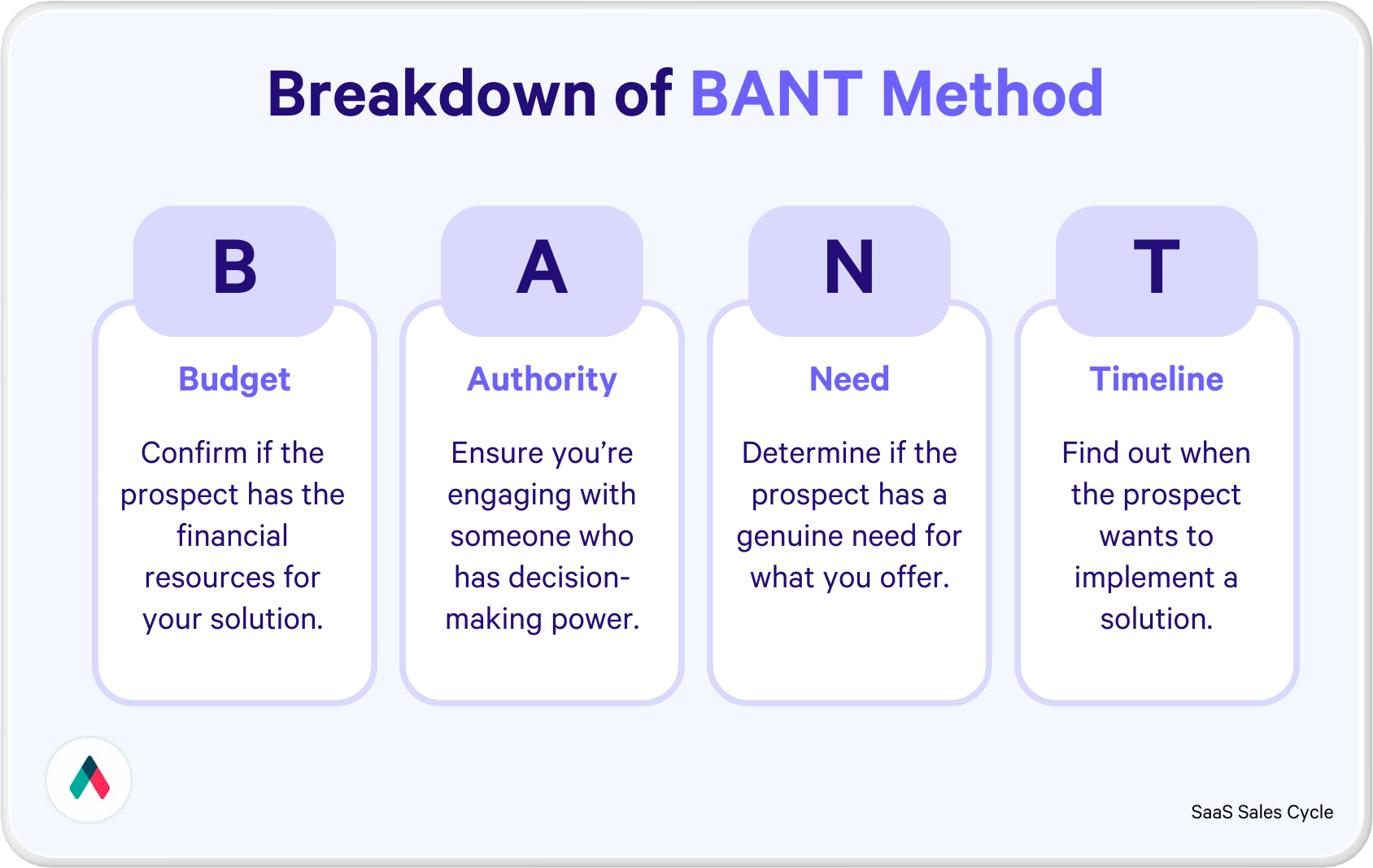
BANT, an acronym for budget, authority, need, and timeline, is a well-known methodology for qualifying prospects early in the sales journey.
The idea is simple: if prospects reveal their budget and introduce you to decision-makers, it's often a green light signaling their readiness to buy. Honing in on their specific needs and purchase timeline further enables sales reps to craft a proposal that hit the mark for both seller and buyer.
However, it's worth noting that BANT doesn’t always hit the mark for effective sales execution. Critics point out that its upfront approach to financial and authority discussions might deter potential leads who are not yet ready to delve into such specifics.
Suitable for: BANT is best leveraged in scenarios entailing less complex deals and where a higher volume of sales is paramount, due to its relative procedural simplicity compared to more intricate methodologies such as MEDDIC and MEDDPICC.
17. N.E.A.T
The N.E.A.T. sales methodology offers a broader perspective and focuses on four key elements: Needs, Economic Impact, Access to Authority, and Timeline.
Sales reps must probe their prospects’ needs and pain points, exploring the challenges that shape their goals. Evaluating the economic impact reveals potential ROI and savings while identifying decision-makers ensures that communication flows to the right ears. By grasping the timeline for decisions, reps can navigate the buying process like seasoned guides, leading to successful outcomes.
Suitable for: This approach works best when you're figuring out if a potential customer is a good fit for your product or service, determining whether it's worth pursuing the sale further. It’s also particularly suitable for sales teams focusing on complex, consultative B2B sales where understanding the buyer’s challenges and aligning solutions to their needs is crucial.
How to implement a new sales methodology
Selecting a sales methodology is half the job—implementing it effectively is equally as important. Regular coaching and training sessions are fundamental for a new or optimized sales methodology to work. Check out these top tips.
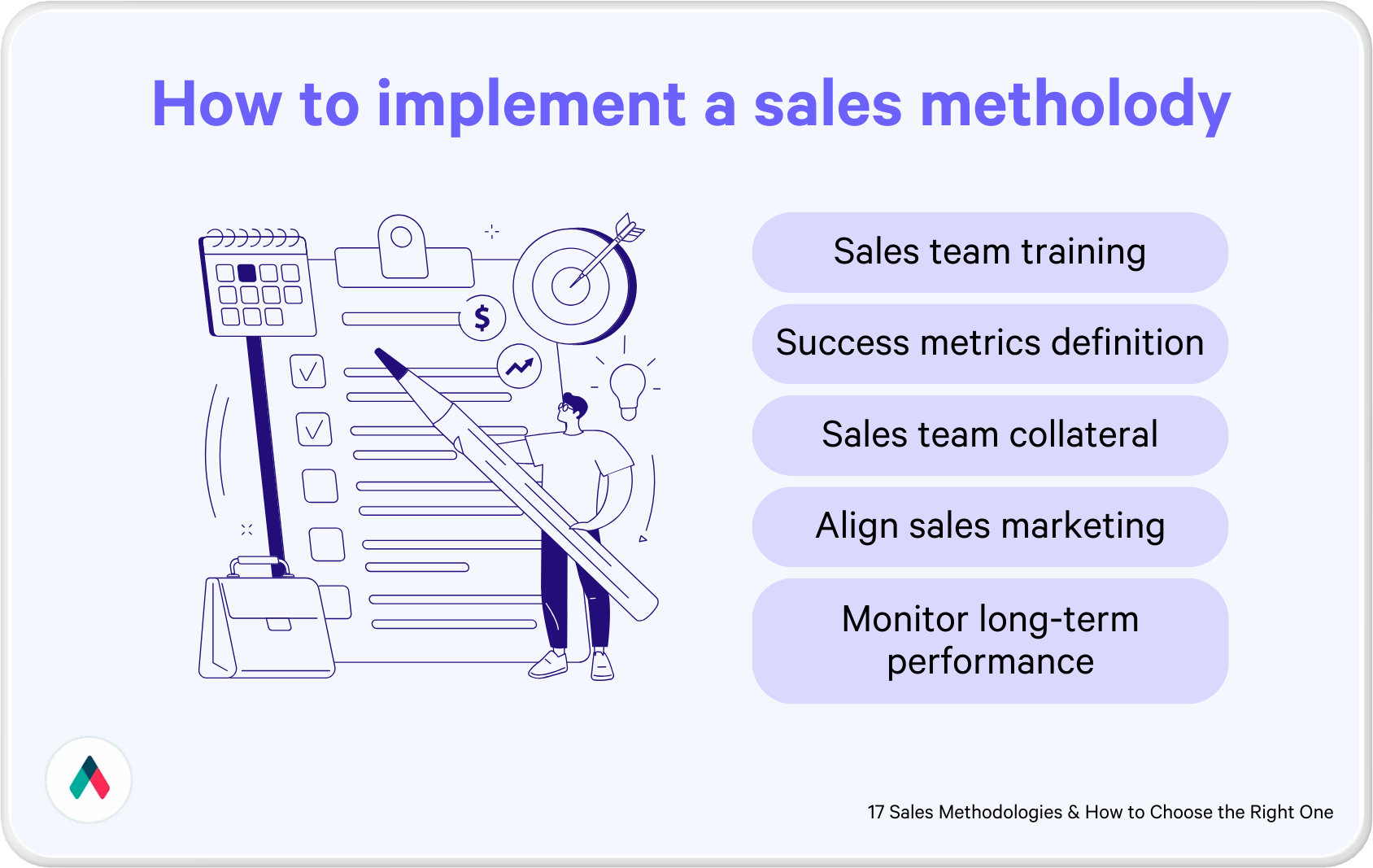
Identify your baseline
Before you can soar to new heights, you need to know where you're starting from. Start by collecting data on key metrics such as conversion rates, average deal size, and sales cycle length. Understanding where you currently stand will also help in setting realistic goals and expectations. This foundation enables you to gauge the effectiveness of your new strategy as you move forward and adjust accordingly.
Analyze sales stages
Breaking down your sales process into distinct stages can provide valuable insights into where improvements are needed. Start by mapping out each phase, then analyze conversion rates and identify bottlenecks or drop-off points at each stage.
Are prospects getting stuck in the consideration phase? Are they losing interest during negotiations? By examining these stages closely, you can pinpoint specific challenges and develop targeted strategies to address them.
Develop a training plan for the sales team
Sales methodologies are a tool to help your sales team. This is especially important for the more complex methodologies, as it’ll help make sure everyone adopts the new approach.
Begin by identifying the skills and knowledge gaps that may exist. Your training plan should encompass product knowledge, sales techniques, and customer engagement strategies that align with the new approach. Incorporate various training methods, such as workshops, role-playing scenarios, and ongoing coaching to cater to different learning styles. The result? A highly-satisfied, wonderfully empowered team.
Prepare for resistance to change and inconsistent adoption challenges
Change can be challenging, and resistance is a natural reaction when implementing a new sales strategy. Anticipate potential pushback from team members who may be hesitant to alter established routines. At this stage, rapport and camaraderie will help when it comes to particularly challenging members who don’t want to play ball.
Earnestly communicate the reasons behind the change, emphasizing the benefits it will bring - not just to the company, but to the individuals themselves. Encourage open discussions to address concerns and foster a culture of collaboration.
“To overcome resistance to change one needs to highlight the benefits of the new methodology. Engage with the team early on by involving them in training sessions and show how the new method will assist them in closing more deals and increase performance. A similar solution applies for inconsistent adoption: ensure that there is proper training for the team and conduct regular check-ins. Also, assign sales coaches to oversee the adoption and assist with any issues. “
Kegan Croxford, Sales Director at Mentally Fit South Africa
Define metrics for success
Choose the most important KPIs that you’re targeting and set goals for the team, so you can easily measure how effective the methodology you chose is. Regularly review and analyze this data to determine what’s working and what needs adjustment. By quantifying success, you not only motivate your team but also create accountability, ensuring that everyone is focused on achieving the defined objectives as you implement your strategy. This should foster enthusiasm and drive in your team and perhaps even encourage a little healthy competition!
Set clear milestones
Something we now know for sure is that it’s all about staff morale! Break down the overall strategy into smaller, achievable steps that your team can work toward. These milestones should be specific, measurable, and time-bound, making it easier to track progress. You could aim for a certain percentage increase in sales within the first quarter, for example, or the completion of training sessions by a specific date.
Importantly, celebrating these milestones as they are achieved not only creates a sense of accomplishment, but also helps maintain momentum throughout the implementation process. The fruits of your labor? A very motivated team.
Create collateral for your sales team
Make it easy for your sales team by creating engaging and innovative collateral for potential buyers! It’s much easier to make a new methodology part of your sales process when the team has everything they need for it. This may involve creating new sales scripts, qualifying questions, and objection-handling strategies that align with the methodology. Other options include presentations and case studies. Ensure that all materials are clear, visually appealing, and easy to use, as they will serve as essential tools during client interactions.
Explore aligning sales and marketing strategies
What is guaranteed to enhance lead quality and improve conversion rates? A happy marriage between sales and marketing. Create a more targeted and effective lead generation and conversion process by getting your sales and marketing teams on the same page. Foster open communication channels between the two departments and encourage regular, structured meetings to discuss objectives. Marketing can provide qualified leads to the sales team, who can then use their expertise to convert those leads into customers. This is set to flourish a new sales strategy.
Monitor and adjust based on long-term performance
A new sales strategy doesn’t end at launch. If the methodology isn’t as successful as you’d like, you might need to make adjustments or offer additional training to your sales team. Track KPIs such as conversion rates, sales cycle length, and customer satisfaction to gauge fruitfulness. Communication is key and that couldn’t ring more true when it comes to managing a team. Regular check-ins with the sales team and collecting their feedback can reveal insights into what’s working well and where adjustments could make a difference.
Sales methodologies might vary, but the end goal remains the same: closing deals that open doors. Bring all of these together and you’ll be working towards a much more optimized sales process—one that helps you close deals faster.
Enable and empower your sales team
If you’re implementing any of these sales methodologies and want an effortless way to fold them into your sales process, try out Qwilr’s sales methodologies templates. These templates make it easy for you to unlock revenue by creating a sales experience that impresses and engages your prospective customers.
About the author

Sarah Taylor|Senior Content Marketing Manager
Sarah leads Qwilr's content marketing efforts – specialising in field marketing, campaign planning, content, brand and communications. Sarah has both agency and global corporate experience spanning Australia, Asia and the UK.
FAQs
A sales methodology is a structured approach that guides how salespeople approach their tasks, such as engaging prospects and closing deals. It includes specific principles, techniques, and strategies that define the way sales activities are conducted. In contrast, a sales process is the set of steps or stages that leads follow from initial contact to conversion into customers. While the process maps out the journey, the methodology shapes how the journey is executed.
- SPIN Selling: Focuses on asking questions about the customer's Situation, Problem, Implication, and Need-Payoff to uncover pain points and provide tailored solutions.
- Challenger Sale: Encourages salespeople to challenge the customer's perspective and provide unique insights that reshape their approach to solving problems.
- Solution Selling: Emphasizes understanding the customer's pain points and delivering a solution that meets those specific needs.
- MEDDIC/MEDDPICC: A qualification framework that emphasizes identifying pain points, champions, decision processes, and competition.
Each methodology is effective because it provides a systematic approach to understanding and solving customer challenges while adapting to the specific industry, customer, or market conditions.
Selecting the right sales methodology requires assessing the organization's industry, target market, and customer journey. Here are steps to guide the selection:
- Analyze Current Sales Challenges: Identify the main obstacles your team faces in closing deals, managing leads, or engaging prospects.
- Understand Customer Behavior: Consider your customers' buying patterns, decision-making processes, and common pain points.
- Match with Business Goals: Ensure the chosen methodology aligns with broader sales goals like improving conversion rates, shortening the sales cycle, or increasing deal size.
- Consider Team Strengths: Select a methodology that leverages the team's skills and can be seamlessly integrated into their existing workflow.
- Test and Refine: Implement the methodology in a pilot phase, gather feedback from the team, and refine the approach based on results.





